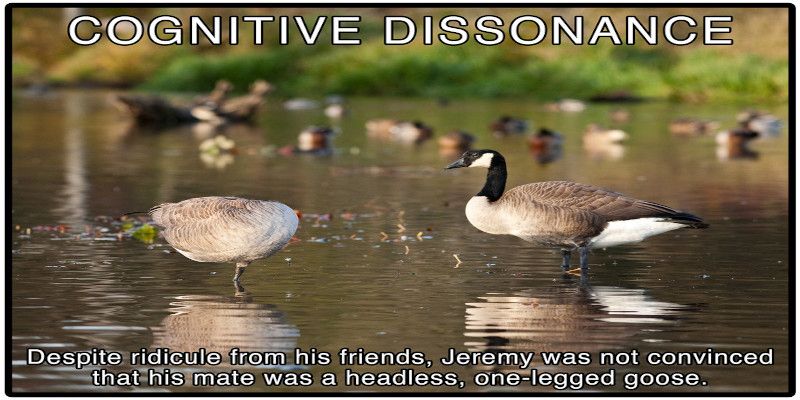Table of Contents
ToggleEver had a feeling of uneasiness after you’ve behaved in a manner that didn’t align with your beliefs and thoughts? Most of us have experienced this before. And this phenomenon is what we call cognitive dissonance in psychology.
It can lead to stress, anxiety, and general discomfort. It’s safe to say that it’s not healthy for both the mind and body.
That’s why we’ll be looking at different ways to learn how to reduce cognitive dissonance.
How to reduce cognitive dissonance

Change your actions
You can reduce cognitive dissonance by changing your actions to match your beliefs.
When your beliefs are right, or if you perceive them to be at least, then your first course of action should be to change your actions to align with your beliefs.
However, before doing so, make sure your thoughts and beliefs are correct. Try to observe them as objectively as possible to prevent biases and prejudices.
Never carry out the actions that made you feel guilty, ashamed, and possibly even angry in the past ever again. Change your actions to what you truly believe to instantly feel better about the whole situation.
Change your beliefs
Changing your belief(s) should only be done when you are certain that they are wrong or suboptimal.
This is a continuous process since we are constantly changing and adapting our beliefs due to new experiences.
I would never advise changing your beliefs if you truly believe in them. As they are what make you unique as a person.
It can be the easiest solution if you don’t trust one of your beliefs anymore, since there’s no personal attachment to that particular cognitive content in play then.
Change how you perceive your actions

A viable option, but not the most preferable one in my opinion.
It is possible to change how you perceive your actions. You can alter the way you remember what happened. You can convince yourself that your actions weren’t that out of line with your thoughts and your beliefs. Or that you had a good reason to act in a manner that’s not in line with your beliefs.
Compartmentalization is a defense mechanism that humans employ to reduce cognitive dissonance.
It works by separating the contradicting feelings and thoughts into different compartments. Thus, it eliminates, or at least reduces, the amount of stress we experience from these conflicting thoughts and feelings.
Perhaps a cognitive dissonance example can make this psychological phenomenon easier to explain. Let’s say that you believe that honesty should be rewarded in life. And that you generally try to be honest with yourself, but especially with other people.
However, you might lie to a friend about why you don’t want to come to their party, or about what you think about their new clothes.
There is obviously a cognitive dissonance at play here since you believe in honesty, but don’t always carry it out yourself and thus, occasionally lie.
You might convince yourself that it is okay since you only do so once in a while, or to spare your friend’s feelings because the truth hurts sometimes. Or by telling yourself that they wouldn’t understand or accept your true thoughts and feelings.
While your actions and thoughts will still be contradicting, you will not struggle anymore, or certainly less due to convincing yourself that you did so for the greater good. That you had a viable reason for acting out of character. This way, you’ll protect yourself from the stress that those conflicting cognitions would awaken.
Again, I would try to alter your actions or, if necessary, your beliefs before attempting to change how you perceive your actions as a solution. As the above will offer a more permanent, and even healthier answer to your problems.

Since cognitive dissonance occurs when two cognitions clash with each other, it seems obvious that we need to do our best to align our thoughts, beliefs, and actions with one another.
Acting out your beliefs truthfully would be my best advice and your best bet for staying mentally healthy. There will be non, or at least much less cognitive dissonance if our actions line up with our cognitions.
Sadly, in our modern lives, we are often pampered, spoiled, and made to feel special. Not to mention that our herd mentality doesn’t help us to think for ourselves or act on what we truly believe in either.
We are regularly fed an illusion, a fairy tale of perfection, and made to believe what society and the media portray as a perfect life. We are frequently busier making the perfect selfie, with the perfect angle, lighting and pose to please people we regularly don’t even know in an attempt to satisfy our need for external validation instead of making true connections in real life.
In our Western society, this is deemed normal behavior and, thus, the new norm. But maybe we’ve strayed too far from what’s normal and natural for us. Perhaps we should use our technology just functional, as a way to connect with others and those we don’t see that often, instead of spending endless hours each day on social media platforms instead of interacting in the physical world.
What is cognitive dissonance?

Cognitive dissonance, also commonly called cognitive dissonance theory, can be defined to describe the uncomfortable tension that comes along from holding two conflicting thoughts at the same time. Or, from engaging in behavior that contradicts with an individual’s personal beliefs.
It can be explained as the perception of incompatibility between two understandings. This cognition can be defined by knowledge which includes emotions, beliefs, attitude, and/or behavior.
What causes cognitive dissonance
This incompatibility between two cognitions drives the mind to invent and acquire new thoughts and beliefs. Or, to change already existing beliefs in such a manner that it serves the purpose to reduce the amount of cognitive dissonance between those two understandings.
How to prevent cognitive dissonance

Talking to a friend
One of the best things we can do to prevent cognitive dissonance is to talk to a friend.
Talking things through with a close one can help put things in order. They often have a more objective view on the matter, since it is harder to stay neutral and maintain a clear head when the very thing involves ourselves.
They can point out inconsistencies or possible hypocrisy in your actions. If they know you well enough, that is. The requisite is that they know how you tick. Otherwise, they can’t figure out what you believe in, which makes it impossible for them to tell if you’re properly aligned.
Therapy
Therapy can be a very useful tool to figure out what might be wrong with our cognitions or behavior.
It allows for an objective look into our soul from an outsider who can be perfectly neutral. Beware though, for therapy to be effective, a bond of trust must be established, and the therapist must be mature and skilled enough to stay neutral, unprejudiced, and unbiased.
On the other hand, the client must be capable of trusting the therapist, willing to work together, and to honestly tell about their feelings and thoughts.
This way, inconsistencies in behavior and thoughts can be laid bare, which can then be improved through hard, and most of all, smart work.
Journaling

Journaling can help you to write down your thoughts, feelings, and personal views about the world.
Not to mention that you can also pen down what actions you’ve taken in the past. What went right, and what didn’t work out according to plan.
This makes it easy to track progress and to check if your actions are in line with your beliefs.
Exercise
Exercising gives us some much-needed downtime and the chance to be alone with our thoughts.
When we are occupied with exercising, we are disconnected from our electronic devices such as cell phones, tablets, and computers. This makes it possible to unplug from social media and from feeling the need to text each other all the time.
We can use this period of inactivity to go over our thoughts, recharge our batteries, and make sure we are acting out our beliefs properly.
Practicing mindfulness or yoga

Practicing mindfulness or yoga gives us a chance to live in the here and now rather than in the past or future.
It teaches us to enjoy the present, to become aware of our body and thoughts, and how we can learn to control them.
Relieving stress will help us to think more clearly and to make better, more conscious decisions. This will help us to behave the way we intended to.
Symptoms of cognitive dissonance

General discomfort without a clear cause
Your brain not only picks up information that is under our conscious control but also the content of the unconscious kind.
This means that our body/mind has a sort of subconscious control mechanism that notices when we are acting out of wack with what we believe in.
Thus, it is possible to sense a general feeling of discomfort, even though we might not always be aware that we aren’t acting per our thoughts.
Confusion
Confusion can be another symptom of cognitive dissonance because having two different cognitions can be confusing. Because which one is right? Which one is wrong? How do we align with each other?
These questions and differences can be confusing for even the most clever of minds. Not to mention that it can be hard to figure out how to accomplish this feat, or even what is going on exactly.
Feeling conflicted

It is possible to feel conflicted, which is basically what you are when two thoughts, actions, or beliefs are different from each other.
Questions arise such as, which one should you believe and follow? Are your actions and rationalizations right? Are your thoughts and beliefs correct? Should you follow what the general masses think and do, or should you follow your moral compass?
People saying you’re being a hypocrite
People saying you’re a hypocrite can often be a surefire way to know that you’re not being honest with yourself and others.
Individuals who say this have probably noticed that you’re acting differently from what you’re saying. Be it out of fear, laziness, jealousy, or all of the above.
Nobody likes a hypocrite, because if you don’t even act out what you believe in, then why would others trust and follow you?
Make sure the person calling you a hypocrite isn’t doing so to simply spite you because they don’t like you. Because some people are vengeful and will say anything to hurt others for their own satisfaction.
Fear of missing out
The feeling of fear of missing out can come forth from the feeling that you’re not living your life optimally or the way you want it to.
This inherently means that your actions are not following what’s going on in your mind. Which means you’re not acting out what you truly think.
Avoidance

One of the symptoms that you’re suffering from cognitive dissonance is practicing avoidance behavior.
Avoiding a problem out of fear or because of laziness doesn’t change the fact that you know something’s wrong and that you should do something about it.
If you don’t, small issues will eventually become large difficulties. Be it sooner, or later.
Avoidance behavior can have multiple reasons. But it generally means that one doesn’t know how to change that very thing they’re trying to run away from.
Although this behavior isn’t helpful in the end, since the concern doesn’t get solved and, thus, will eventually arise again. Even when suppressed in the immediate present or near future.
Not to mention that we know that the things we avoid, tend to grow in strength over time.
Ignoring the facts

Ignoring facts can mean one is trying to rationalize their cognitive dissonance and trying to reason their way out and trick themselves into why they’re holding conflicting views and actions.
This becomes a lot easier to do when one chooses to ignore the facts. Of course, even rationalizing your thoughts will eventually end up biting you in the ass, since the issue often doesn’t get eliminated.
Rationalization
Rationalizing is something people typically do as a coping mechanism to reduce stress and anxiety.
People decide to rationalize their cognitive dissonances and trick themselves into why it’s okay to hold these conflicting beliefs, thoughts, and behaviors.
Of course, this can be beneficial as well if the problem isn’t solvable. At least it helps to reduce stress and to make it more manageable.
Shame

We feel ashamed when we do something we know we shouldn’t do. And people typically know when they’re doing something they don’t believe in, and for good reason.
People are herd animals, and thus, we regularly follow the herd. This isn’t inherently bad, and can even be beneficial at times. But, never doing what you believe in isn’t good either, since everyone is different and unique.
This means that there’s no single inherently correct path to walk in life that’s suitable for each person. And each plan in life should be adjusted to the individual.
Guilt

Feeling guilty is in the same boat as feeling ashamed. It means you know you’ve done something wrong or something that you know you shouldn’t have done.
We often feel guilty when we aren’t acting out what we believe in. Because we are following other people’s beliefs that we perhaps know aren’t right or not adjusted to our own.
But guilt isn’t always bad, although it is most certainly not fun. It alarms us and makes us aware of the fact that we are doing some things that need sorting out. It notices us that we are acting out of wack, so to speak.
Feeling guilty or ashamed aren’t feelings that need to last forever. If we decide to search for the reason(s) why these feelings/symptoms flare up, then we can fix the problems at their very essence and prevent them from happening again in the future.
Final take

Don’t lie to yourself, and make sure your actions align with your beliefs.
Although cognitive dissonance is quite common, it is something that we should try to avoid and prevent, since it hurts our physical and mental health.
Authenticity is key here since acting out your beliefs and thoughts will lead to no internal turmoil while behaving in a manner that you don’t believe in will lead to stress, anxiety, and possibly even getting sick.
Simply try to be yourself, no matter what other people think of you. The rest is already taken.









2 thoughts on “How to reduce cognitive dissonance: Align thoughts, beliefs, and behavior”
Comments are closed.